We present an 81 year old gentleman with haematuria and LUTS who had TURP for his outflow symptoms. Radiotherapy is an excellent option for local symptom control as evidenced in this patient.
Authors: Venugopal S, Das.S, Hamid BN, Doyle.G, Leggat H, Powell CS. Countess of Chester Hospital NHS Foundation Trust
Corresponding Author: Suresh Venugopal, Countess of Chester Hospital NHS Foundation Trust Email: sureshvenugopal@gmail.com
Abstract
Haemopoietic malignant infiltration of the prostate is unusual. When present, it brings about the dilemma on the best approach to manage it. Usually, chronic lymphocytic leukaemia is an indolent process that waxes and wanes in its course and when present with lymphadenopathy and clinical symptoms would warrant treatment with chemotherapy. When organ confined, it has a more favourable course and would be amenable to local treatments.
We present an 81 year old gentleman with haematuria and LUTS who had TURP for his outflow symptoms. The histology had confirmed a malignant lymphocytic infiltration of the prostate and he had elevated lymphocytic count and peripheral blood marker study confirming chronic lymphocytic leukaemia. He was treated with radiotherapy of his prostate. His presenting WBC count was 19.2 and PSA was 4.41 and presently his white count is 10.3 and PSA is 1.77. He was treated with 24 Gray external beam radiotherapy to the prostate.
As we encounter an aging population, we will be seeing more of these cancers with higher incidence in the elderly. Radiotherapy is an excellent option for local symptom control as evidenced in this patient.
Case Report
Presentation
An 81 year old gentleman had simultaneous referral to the haematologist for low haemoglobin and raised white count and the urologist for visible haematuria and LUTS. A digital rectal examination revealed a smooth, benign-feeling prostate with a normal age-specific PSA. A CT scan done to evaluate his haematuria had picked up a large mass in the pelvis. It was difficult to differentiate whether it was of bladder or prostate origin (Figure-1).
Figure 1: CT scan showing pre treatment pelvic mass (left) and post treatment pelvic mass (right).
Trans-urethral resection of the mass showed diffuse infiltration of the prostate gland by a malignant B-cell type lymphoid infiltrate. His peripheral blood markers for chronic lymphocytic leukaemia were positive. He did not have generalised lymphadenopathy, splenomegaly or B type symptoms of leukaemia.
Pathology
The trans-urethral resection chippings of prostate showed large foci of basal cell hyperplasia and extensive infiltration with monotonous population of small lymphoid cells (Figure-2).
Figure 2: Prostate tissue infiltrated by lymphocytes staining strongly for CD20 (left) and H&E staining showing sheets of monotonous lymphocytic infiltration of prostate (right).
The abnormal lymphoid infiltrate stained positively for CD5, CD20, CD79a but was negative for CD3, CD10, BCL2 and BCL6. This is keeping in with a picture of Chronic Lymphocytic Leukaemia of Prostate. There was no evidence of high grade PIN or adenocarcinoma of prostate.
Radiotherapy
In view of his symptomatic haematuria and potential for the lesion to cause local symptoms of persistence of haematuria and possible obstruction of adjacent structures, he was considered for radiotherapy after due discussion at the multidisciplinary team meeting. The pros and cons of the treatment was discussed with the patient and he opted to have the treatment. He received standard 24 Gray in 12 fractions for low grade lymphoma of the prostate (1).
Follow-up
He has since been regularly followed up at the urology clinic for his lower urinary tract symptoms with a flow rate and rectal examination on the six monthly visits as well as a yearly PSA test. He does not have any lower urinary tract symptoms. His six monthly follow-up in the haematology clinic for his Chronic Lymphocytic Leukaemia involves assessing the presence or absence of B symptoms of leukaemia as well as a peripheral blood smear assessment. At the end of three years a re-biopsy of the prostate revealed the presence of a residual malignant lymphomoid infiltrate (Figure 3).
Figure3: Core biopsy specimen showing lymphocytes staining strongly for CD 20 (left) and H&E staining showing monotonous lymphocytic infiltration of the core biopsy specimen of prostate (right).
A rescan showed the persistence of the pelvic mass but without increase in size and without any accompanying symptomatic haematuria or obstructive features.
Discussion
Infiltration of prostate by Chronic Lymphocytic Leukaemia is not an uncommon finding in patients with CLL. Autopsy studies have revealed CLL as the commonest secondary tumour of the prostate. Leukemic infiltration is symptomatic in only 1% of them (2). They usually present with outflow obstructive features. Chronic lymphocytic leukaemia has an indolent course with waxing and waning of the white cell count. As a haemopoietic malignancy involving the prostate, it cannot be cured by local therapies, though this has been claimed on short term follow-up in literature (3,4,5).
The prostatic component of the disease is best dealt with by radiotherapy if local problems are anticipated. Chemotherapy is reserved for patients who have systemic disease progression. Outflow obstruction is best relieved by Trans-urethral resection of the prostate. Though various doses have been cited for curative treatment of this disease, this claim is to be disputed. We currently recommend a dose of 24 Gray in 12 fractions for palliative control of symptoms as per the recommendation for a low-grade non Hodgkin’s lymphoma.
Urological follow-up of these patients is as that of other patients with outflow symptoms, who generally get a flow rate and rectal examination assessment. In addition they need to have continuous follow-up at a haematology clinic for monitoring their systemic symptoms, which may dictate the need for further intervention.
Lesson learnt:
• Leukaemic infiltration is not uncommon.
• It usually presents as bladder outflow obstruction requiring TURP.
• Radiotherapy is indicated only if local complications are anticipated and is not always curative.
References
1) https://www.rcr.ac.uk/docs/oncology/pdf/DoseFract_49_Lymphoma.pdf
2) E. H. Eddes et al, Urinary symptoms due to leukemic infiltration of the prostate A case report, Ann Haematol 1993, 66:323 – 324.
3) Mitch Jr et al, Leukemic infiltration of the prostate: A reversible form of urinary obstruction, Cancer 1970, 26: 1361-1365.
4) Belis JA, Lizza EF, Kim JC, Raich PC, Acute leukemic infiltration of the prostate. Successful treatment with radiation, Cancer 1983, 51: 2164–2167.
5) Belhiba H et al, Prostatic involvement in leukemia. Report of a case Progrès en Urologie 1992, Aug-Sep;2(4):650-2.
Date added to bjui.org: 15/12/2010
DOI: 10.1002/BJUIw-2010-063-web




























